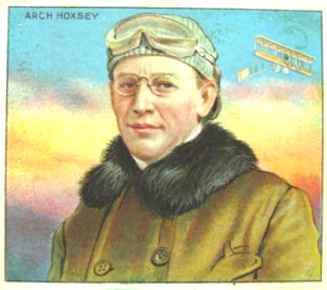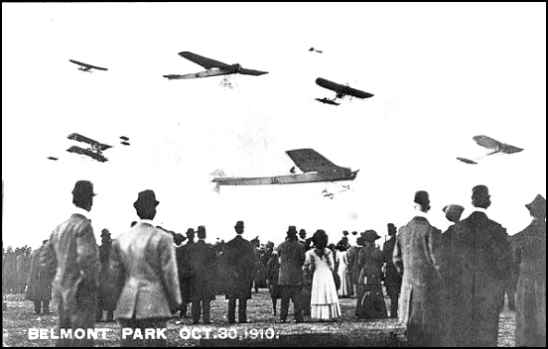

 |
 |
|
|
| ARCH HOXSEY was born at Staunton, Illinoies, October 15, 1884. He went to Califronia with his parents when a young child. He became interested in automobiles when only a boy and remained in that trade for four years. His understanding of machinery and the daring he manifested recommended him to the Wright brothers and he entered their service when he was eighteen. He worked in their aeroplane factory and becasme one of their most skilled mechanicians. He first attained prominence as a driver at Asbury Park, N. J., in September, 1910, and was at once looked upon as one of the most daring of professionals. He held the American record for sustained flight across country, making 190 miles from Springfield, Illinois, to Clayton, Missouri, in October, 1910, and took ex-President Roosevelt for a flight at St. Louis. He flew from Los Angeles to Mt. Wilson and return on December 29, making an altitude of 10,500 feet, and later rose to more than 11,000 feet. He was killed the last day of the year, when returning to earth in a series of perilous glides. |
|
AT MIDDLE ISLAND Written by Peter Kockenmeister Airline Pilot, Northwest Airlines Former USAF Instructor Pilot This is a really fascinating story of the Belmont Park meeting in 1910. The author has written an account of the meet which includes much of the color associated with the activities of the primary participants including Ralph Johnstone and Arch Hoxsey. It is a priceless contribution to the online community and I am sure will be much appreciated. To visit the site, just click on: This story is one of several found on the Longwood's Journey website. The purpose of the site is characterized as follows in their introduction. "Welcome to Longwood's Journey. This site will provide you with a historical overview of the Longwood community, located 50 miles east of New York City.Through the efforts of the Social Studies students at Longwood Middle School, local historians, and residents around the world, as well as primary source material, this project is continually being updated and added to. Our goal is to gather as much information as possible in order to share our community's rich history and its contributions to American heritage." To visit the homepage of the site, just click on: |
 |
|
Photo and text from Roy Nagl, 10-6-05 |
 |
|
Library of Congress Collection |
|
from The New York Times Sunday, November 6, 1910 Machine translated from the French The meeting of Belmont Park began under torrents from water. The few enough courageous pilots to face the elements the first day transfer their engines to cough, spit and stop, drowned lighting. Grahame-White covered to it his with a cover and installed a heater below. Thus dorlotée, mechanics agree to awake and the English was once more the first to take off. The following days, there was, with the improvement of time, up to three or four planes in the air together (twelve same, once) and, enough of acrobatics to hold crowd in breath. The daring landings of Charlie Hamilton tore off cries with the witnesses. "be an about sixty meters height", told one of his/her comrades, "it was put in piqué, rectified to approximately 1,50 m of the ground and stopped on the line, just opposite the large platform. People found that formidable " The high-speed motorboats of the Wright team were Arch Hoxsey, 26 years and Ralph Johnstone, 24 years, baptized "The Stardust Twins" by the journalists. The first, mechanic and famous racing driver, had precipitated at Wright to take lessons of piloting after having attended the air meeting of Los Angeles in January. Johnstone, of Kansas City, Missouri, was an acrobat. Its number consisted in jumping of a springboard to bicycle, exercise so perilous that a friend advised to him to choose a less risky trade. Johnstone, after reflexion, had launched out in aviation. The "Twins" filled the columns of the newspapers while devoting themselves to a pitiless duel in the meetings. Of all the pilots of Wright they were boldest, a little too even with the taste of Wilbur. Little before the meeting Belmont Park, it had temporarily prohibited Hoxsey besides from flying to have devoted itself to too many eccentricities during a meeting with Detroit. The most remarkable exploit of the "Stardust Twins" with Belmont Park had not been envisaged with the program. While they made an effort one and the other to beat the record of altitude they faced a head wind if violent one that it obliged them to move back. Johnstone calculated that it flew at a relative speed of 65 km/h against a wind of 130 km/h. It succeeds in being posed in a clearing with 90 kilometers of the ground and mooring its plane with a tree before it is not carried. Hoxsey, taken in the same wind, traversed only 40 kilometers, behind him too. It was, as pointed out it Wilbur Wright, "the first flight in open country with move back". Thus put in condition, crowd awaited impatiently the principal event of the meeting, the Cut Gordon Bennett. Like habit, Grahame-White was the first with the departure, followed by the Leblanc French, who had protested in vain against the dangers of the circuit and which controlled to him also Blériot but of a scale a little lower and provided with a propeller with shorter step. At the 17th turn, the engine of the English started to heat, turning russet the fuselage. The irritated throat and the sight scrambled by smoke, it however managed to finish the course, just at the moment when Leblanc. to gasoline court, its apparatus with the one of the telegraph poles hung of which it had underlined the danger before the beginning of the test. Walter Brookins, head pilot of Wright, prepared his Baby Grand for the race when Leblanc was crushed. He took off in order to see what occurred but, a strong wind postpones pushed it, he reached 160 km/h and ran a rod. "I tried to pose to me as slightly as possible", told it, "but the fragile landing gear could not support this terrifying speed." The train was crushed indeed and Baby Grand started to make barrels. "the three or four first were enough for me, declared Brookins. I jumped and what remained plane was still devoted to good ten capers. I had wanted to go to see what had arrived àLeblanc and when one brought it to the hospital of countryside, it is me which awaited it on the operating table." None of the two men was seriously wounded but, Baby Grand and it fast Blériot de Leblanc being except race, no one could not beat the record of Grahame-White, which covered the 100 kilometers into 61 mn 4,74s. In fact, three others only control finished the race and Bracing, classified second, put nearly one hour more than the winner, including 38 minutes on the ground to repair. The final test of the meeting, a race of 53 kilometers above the city and the wearing of New York with turn around the statue Freedom and return, caused new protests. It was open in theory only to the pilots having achieved a flight of at least an hour during the meeting, but as well few aviators except Grahame-White met this condition, the organizers declared the test open to all. The English deposited a complaint, which was rejected, and it planned to be withdrawn. In spite of this modification of the payment, it was not enough competitors for a true competition. The race took place one Sunday and neither Wright nor their team stole the Sunday; Bracing John was apparently eliminated in advance after having demolished his Blériot in a collision on the ground with Farman de Clifford Harmon, and only in string the count Jacques de Lesseps remained (grandson of the manufacturer of Suez Canal), of the Blériot team. But at the last time, Grahame- White, undoubtedly stimulated by the fact that its apparatus outclassed that of Lesseps, decided to take too the departure him. Between the two Blériot, the part was far too unequal. Lesseps took off the first but the English exceeded it soon and had 65 seconds in advance while arriving close to the balloon attached to the statue which announced the half-turn. He finished the race in the howl of the sirens of boats. One carried it in triumph around the ground, wrapped in the folds of the British flag, when one announced by loud-hailer that the competition was not finished, John Bracing being presented on the starting line with new Blériot at 4. 06, that is to say 21 minutes after the official hour fixed for the test closure. The judges, on this occasion, had still taken freedoms with the payment. Bracing, although it had lost its plane in the collision on the ground, had not given up the Cut. With his/her brother Alfred, the banker, they had located Blériot holds some in the hangar of Leblanc and decided to buy it. While John dealt with making change the serial numbers, Alfred called Leblanc with his hotel of Manhattan to operate the transaction. The French, partly given of its accident, was made lead in the car to Belmont Park; after a tightened discussion, Bracing Alfred finishes by him offering 10 000 dollars, summons quite higher than what was worth the plane, and the business was concluded. A cheque, borrowed from the one of the enthusiastic witnesses who pressed themselves around them, changed hand and, ten minutes later, Bracing John rolled to the starting line on Blériot whose painting of the numbers was still fresh, and it took off. A shiver of excitation traversed crowd while the apparatus disappeared at the horizon: the race could still be gained by an American. Less than one half an hour later, Blériot reappeared and lands while crowd is delirious about it howled her joy. After deliberation, the judges announced that Bracing carried it 43 seconds. This victory was extremely contestable, but the enthusiasm of the witnesses broke out. Wilbur Wright lost even its measured with compasses maintenance of it and, with the statements of a British journalist, one saw it "trampling his hat and pushing cries of Indian comanche". Bracing was carried in triumph around the track, draped in the American flag. Grahame-White was furious; it required that one start again the race, sent a telegram of protest flamer to the international aeronautical Federation in Paris and offered to face Bracing anywhere for a stake of 10 000 dollars. The American refused: "This man is definitely the worst loser whom I ever met, he says. I beat it once on an apparatus less powerful than it his. Why would be likely I to break me the neck to beat it again?" It took more than one year to slice the disagreement, but, finally, the F.A.I. cancelled the decision of the judges at a meeting in Rome and, in 1912, during a dinner from the Aero club in New York, Grahame-White accepted finally its cheque of 10 000 dollars, accompanied of more than 500 dollars of interests |


|